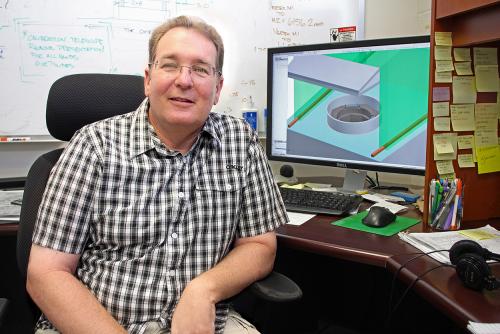LSST Design Engineer John Andrew always enjoyed taking things apart, seeing how they worked and putting them back together again – an interest put to good use during his recent project coordinating the disassembly and relocation of the Calypso telescope from Kitt Peak to NOAO in Tucson. Although arguably also applicable to his childhood aspiration of becoming a doctor, it is a predilection probably more suitable for engineering. Medicine’s loss is LSST’s gain.
John previously worked on the SOAR project, where he tested components and participated in final assembly of the primary mirror lateral link assembly. Those kinds of moments represent what he described as the most satisfying element of his work – seeing a design go from a basic concept to a complete working piece of hardware. It is a satisfaction he looks forward to experiencing with LSST. At SOAR, John worked with Victor Krabbendam (now LSST Project Manager) and future members of the LSST Telescope and Site subsystem team. John “enjoyed working with everyone on the SOAR project, so when LSST was looking for a designer, I applied.” He joined the LSST in project in November 2005.
John credits his grandfather for sparking his interest in mechanical things. “He worked in the locomotive casting industry and got me interested in mechanical drawing. I took mechanical drawing in school and really enjoyed it.”
At first John thought he wanted to be a doctor, but “when I found out how long I had to go to school for it I decided it wasn’t for me.” Instead he graduated from Hudson Valley Community College in 1985 and took a job with General Electric Large Transformer Operations in their drafting department. In 1988, Beloit Corporation hired him as a mechanical designer for automated paper making equipment. In 1996, he moved to Tucson and joined NOAO in the instrumentation department.
In addition to being responsible for LSST’s future calibration telescope, John oversees the observatory coating chamber and the Project’s repository of Computer Aided Design (CAD) drawings. LSST will be the most complex system John has worked on. The current CAD database for the LSST Telescope and Site subsystem contains more than 13,400 files.
“I estimate that when we finish construction,” John said, “that database will have tripled in size.”
To wrangle that amount of data, John has implemented a product data management (PDM) system. PDM is a tool focused on managing and tracking the creation, change and archiving of all information within the CAD database. It serves as a central repository for the drawings, their metadata, and their history.
In his free time, John enjoys golf, camping, off-roading, and watching football and auto racing. He said off-roading and auto racing appeal to him for the same reasons he was originally drawn to mechanical engineering. “The rest just keeps me sane.”


